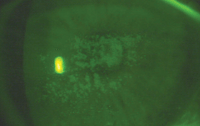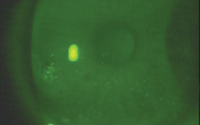 In the previous two columns, Brooke Messer, O.D., discussed innovative scleral lens applications. In the series’ final column, I will introduce a non-traditional way that scleral lenses can be prescribed.
In the previous two columns, Brooke Messer, O.D., discussed innovative scleral lens applications. In the series’ final column, I will introduce a non-traditional way that scleral lenses can be prescribed.
A Case Study

1. Corneal staining O.D.
JJ is a 59-year-old female with a history of dry eyes and ocular allergies. Her history is significant for hard lens use many years ago and a facelift three years prior to her visit with me. She was referred to my office after expressing an interest in wearing contact lenses again. She reported using lubricating eye drops as needed and started Restasis (Allergan) at her recent exam. She said she wore her eyeglasses for driving, but otherwise did not use corrective lenses because she could not see at near very well with them.
Her entering acuity without correction was 20/70 O.D. and 20/150 O.S. Her near vision was 20/40 O.D. and 20/30 O.S., again without correction. Keratometry showed a K of 43.00 x 45.50 O.U. Her refraction was -4.25 + 2.75 x 30 to 20/25-2 and -5.00 + 2.50 x 135 to 20/20-2. Slit lamp exam revealed corneal staining in both eyes.
After examining JJ, my initial impression was that she was not a good candidate for contact lenses due to her complex RX, her minimal use of glasses and her ocular health. Soft torics, in the form of monovision or multifocals, would likely not work for the above-mentioned reasons. GP lenses might correct her vision acceptably, but would she tolerate them and would they have a negative impact on her ocular health? Although we could have launched her on a regimen to improve her dry eyes, follow up to gauge improvement and then consider contact lenses, this treatment plan did not seem ideal.

2. Corneal staining O.S.
Contact Lens Therapy
Most practitioners who treat ocular disease likely consider contact lenses to be another complication. I suggest prescribing contact lenses as part of the therapy. I talked with JJ about the option of using scleral lenses to both help her dry eye and correct her refractive error. She was intrigued. When I suggested that perhaps we could add a bifocal to her lenses as well, she was excited.
I chose the Digiform scleral lens N series (Truform) for normal corneas, and achieved a nice fit in each eye with the following parameters: 7.65 base curve, 15.0mm diameter, standard peripheral curves, +2.25 add and 2.0mm near add zone all parameters O.U. in Boston XO. The base prescription was -1.62 in the right eye and 3.00 in the left eye.
I selected the 15.0mm diameter to make sure the lens was optimally centered. With larger lenses, inferior decentration can be more common, which could create problems with a small central near zone.
The Result
JJ reported good comfort and vision—specifically improvement in her distance vision, while maintaining her ability to read. Her acuity was 20/20-2 O.D. and 20/20-1 O.S., 20/20 O.U. at distance. Her near vision was 20/25 in each eye. She was managing to apply and remove the lenses properly, and scheduled a two-week return visit.
At the follow-up, she reported that she was able to wear the lenses for most of the day with good vision and comfort. Her corneal staining, while not resolved completely, showed improvement compared to her pre-fitting condition. Overall, she was doing quite well and was happy.
This case demonstrates the versatility of scleral lenses, and the success you can achieve when you think outside the box. Keep in mind that scleral and corneoscleral lens manufacturers can make bifocal or multifocal design lenses on request.
This series on getting creative with scleral lenses is based on a simple motto: If you can imagine it, you can do it. As the manufacturing capabilities continue to advance, the number of opportunities to use these lenses multiplies.


